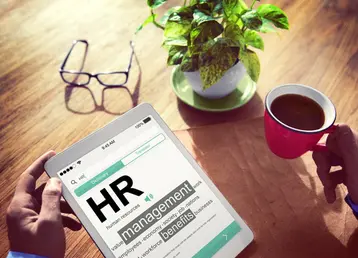What You Need to Know About the Latest HR Technology Trends

Table of contents
- 1.Process
- 2.Data Capture
- 3.Workflow
- 4.Flexibility
- 5.Compliance
- 6.Security
Business today is all about leveraging the power of technology for efficiency, security and convenience. With new cloud technologies, automating your HR tasks doesn’t need to be cost-prohibitive. Instead, it can be an indispensable tool for managing your most important resource (your employees) at an efficient price and pace.
Human resources creates dozens of pieces of paper for every employee, including applications, background checks, insurance, employment and benefits forms, and post-separation forms.
Luckily, there is an answer to dealing with paper, and achieving more oversight and control over HR records. Mobile HR and cloud applications are changing the way people work – helping to alleviate the cost and time burdens of managing documents and ushering in a brand new era of data management.
Modern HR technology is changing the way applications are designed for sharing, collaboration and increased productivity. With a myriad of new cloud-based software systems on the market, HR managers can reap the rewards of streamlined information management.
According to PayStream Advisors, organizations gained an average of 84% savings in processing costs when moving from a novice HR organization with no automation to an innovator HR organization that is highly automated.
Applicant tracking software (ATS) and predictive talent selection software (PTS) offer potential employee assessments, reference checking, interview analysis and data insight technology. Human resources management software (HRMS) help to track and process efficiency and organizational management tools. Enterprise resource planning (ERP) tools help link the financial and administrative functions of an organization for complete business management of everything from product planning and service delivery to sales and marketing.
The migration of HR applications to the cloud enables organizations and their employees to enjoy increased flexibility, dexterity and responsiveness. As with many business functions, the ultimate goal in HR is to have enough efficiency and collaboration to allow insight into the workings of an organization. Saving time on administrative HR processes means business owners and managers are free to spend more time on their core business function.
A recent survey by PriceWaterhouseCoopers found that 70 percent of companies with cloud-based HR and payroll had fewer than 5,000 employees, meaning that small and midsize businesses are leading technology shift to cloud-based software.
All paperwork related to HR can be managed securely using cloud-based systems, making it easier to access, collaborate on and complete HR functions, including:
Process
With cloud-based software, managers can quickly process and route prospect and new hire paperwork, ensuring efficient approvals and improved turn-around times. Many systems offer built-in workflows to make sure the right people have the right information at the right time so that all company protocols are met.
Data Capture
Using advanced data capture technology, you can capture information from any source, including emails, paper documents, file sharing systems or even faxes. Then you can automatically assign this data to a document that is centrally stored and easily accessible from other cloud-based HR systems.
Workflow
A paper or digital resume with references can be uploaded in seconds, shared with the right staff member and stored for later access – streamlining the records management process, reducing the costs associated with paper and saving time. All forms - from pre-employment documents to benefits, training and certifications, medical and insurance records as well as wage and salary data - can be stored and accessed from other HR systems.
Flexibility
Gone are the days of being chained to a computer. According to a recent Gallup Poll, one-third of employees are utilizing their mobile devices to access work after hours and 96 percent of full-time American employees say they use at least one of their own devices to access work-related content. Increasingly, employers and employees are utilizing their phones, tablets and other mobile devices to stay connected to their work. Cloud-based systems offer the flexibility of anywhere, anytime access - so you can review a new employee resume from the airport, or send an approval for a salary increase from your remote office.
Compliance
Those that have been in the workforce long enough remember the days of stressful audits, searching through stacks of paper forms and boxes of files. No more. With 24x7x365 accessibility, cloud technologies like enterprise resource planning (ERP) and document management system (DMS) software help ensure compliance with legislative acts like HIPAA, ADA and the Affordable Care Act. Documenting and accessing payroll, benefits, medical, workers compensation, OSHA and other communication is accurate and efficient.
Aberdeen’s Core HR and Workforce Management Study found that when data security was in place to maintain compliance and privacy of HR data, organizations saw an improvement in compliance that was 5 times greater than thoe who did not.
Security
With full redundancy, cloud-based document management systems can protect your important documents, from contracts and invoices to sensitive legal and financial data. The greatest benefit of a cloud-based management system is anytime, anywhere access. Organizations leveraging cloud technology don’t have to worry about physical documents stored in filing cabinets or at an off-site location. By using a secure online platform, business will continue to operate using any Wi-Fi enabled device - regardless of weather or other emergency conditions. Your business workflow can continue across the country while keeping your data secure.
HR departments can enhance productivity and streamline operations with cloud-based solutions that have a lower cost of entry than traditional on-site solutions, and are easier to utilize, update and access. Focus on issues around employee retention and satisfaction – not chasing paper.
This communication is for informational purposes only; it is not legal, tax or accounting advice; and is not an offer to sell, buy or procure insurance.
This post may contain hyperlinks to websites operated by parties other than TriNet. Such hyperlinks are provided for reference only. TriNet does not control such web sites and is not responsible for their content. Inclusion of such hyperlinks on TriNet.com does not necessarily imply any endorsement of the material on such websites or association with their operators.

Jeff Frankel

Jeff Frankel
Table of contents
- 1.Process
- 2.Data Capture
- 3.Workflow
- 4.Flexibility
- 5.Compliance
- 6.Security





